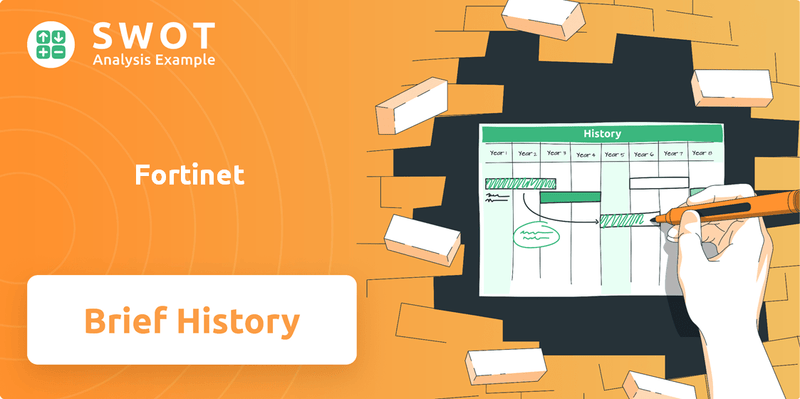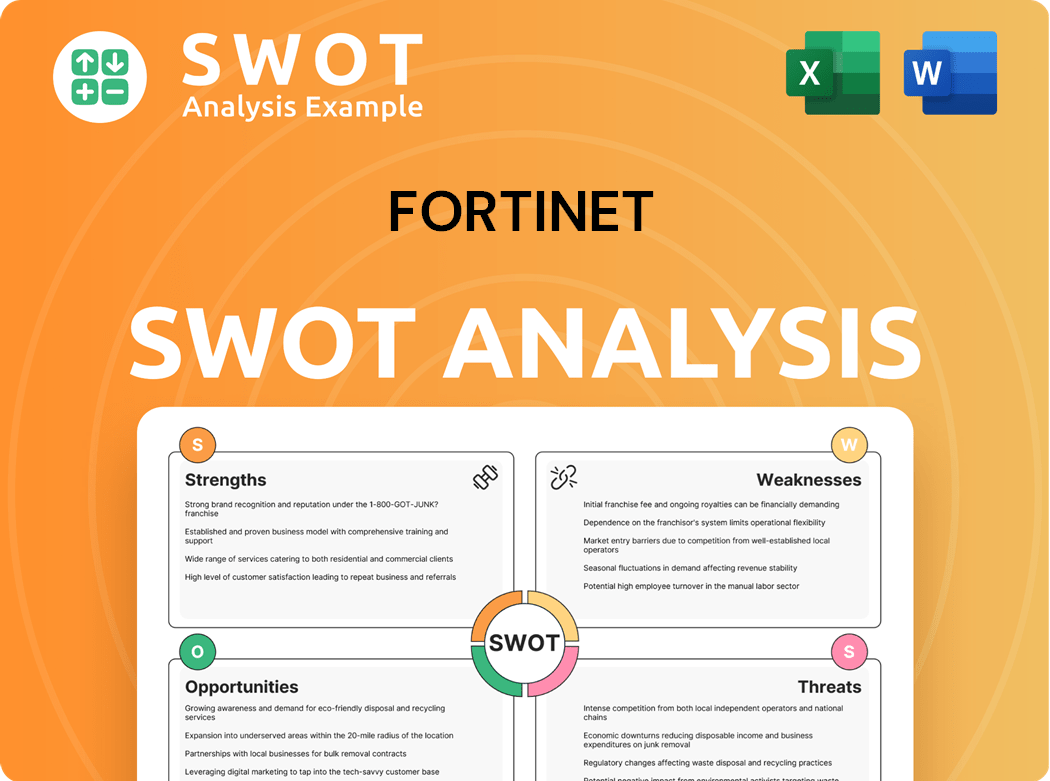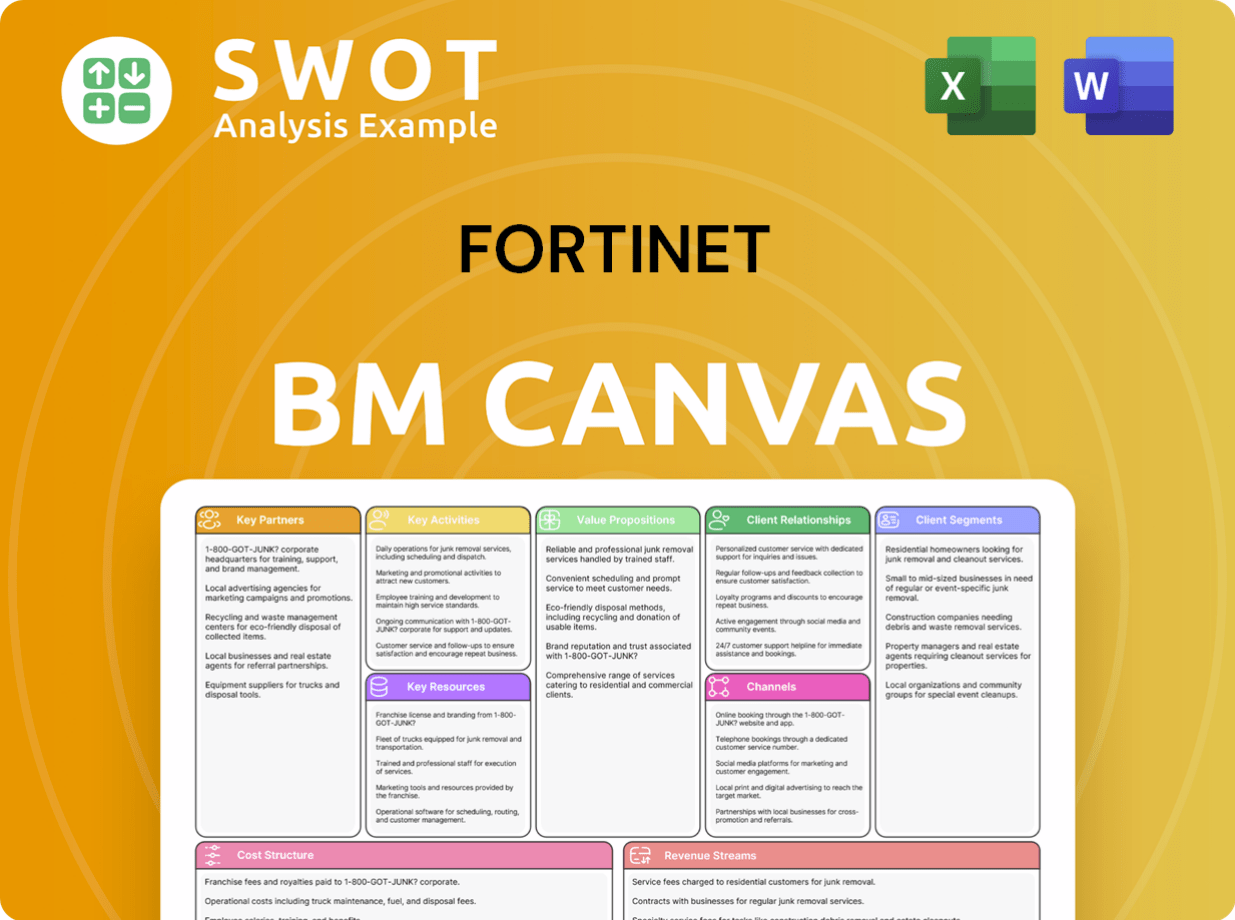Fortinet Bundle
How did Fortinet go from a startup to a cybersecurity giant?
In the ever-evolving world of digital threats, understanding the Fortinet SWOT Analysis is key. Fortinet, a major player in cybersecurity, began its journey in 2000 with a groundbreaking vision. This brief history delves into the remarkable evolution of the Fortinet company, examining its pivotal moments and strategic decisions.

From its inception in Sunnyvale, California, by Fortinet founder Ken Xie, the company focused on delivering integrated security solutions. Its early products, particularly the FortiGate firewall, set the stage for its future success. This exploration of Fortinet history reveals how it navigated challenges and capitalized on opportunities, establishing its significant market share in the cybersecurity landscape.
What is the Fortinet Founding Story?
The story of the Fortinet company began on October 26, 2000. It was founded by brothers Ken Xie and Michael Xie. Their vision was to address the growing need for robust network security solutions in an increasingly digital world.
Ken Xie, drawing from his experience in network security and his previous success at NetScreen Technologies, saw a market gap. Michael Xie brought his expertise in engineering and product development to the table. Together, they aimed to create a unified security platform.
The company's early focus was on integrated security appliances. These appliances combined various security functions into a single, efficient platform. The initial funding came from the founders themselves, using their personal capital and industry connections to get started.
The company was founded to solve the problem of fragmented security solutions. The initial product was the FortiGate firewall, a hardware appliance. The name 'Fortinet' reflects the company's mission to secure networks.
- Fortinet was founded on October 26, 2000.
- The founders were Ken Xie and Michael Xie.
- The first product was the FortiGate firewall.
- The company's name is a combination of 'Fortified Networks'.
The founders identified the need for a comprehensive approach to network security. They aimed to simplify security management and reduce vulnerabilities. The early 2000s, with the dot-com bust and rising cyber threats, created a favorable environment for Fortinet.
The initial business model centered on hardware appliances offering multiple security functions. These included firewall, VPN, antivirus, intrusion prevention, and content filtering. This approach provided a consolidated solution, which was a key differentiator in the market. You can learn more about the company's financial aspects in this article: Revenue Streams & Business Model of Fortinet.
Fortinet SWOT Analysis
- Complete SWOT Breakdown
- Fully Customizable
- Editable in Excel & Word
- Professional Formatting
- Investor-Ready Format

What Drove the Early Growth of Fortinet?
The early years of the Fortinet company were marked by rapid expansion and strategic moves within the cybersecurity sector. Following the introduction of the FortiGate firewall, the company quickly gained recognition. This was due to its innovative ASIC-accelerated architecture, which provided high performance for integrated security services. The company focused on a unified threat management (UTM) approach to simplify security infrastructure and reduce costs.
Fortinet's initial product offerings included various FortiGate models, targeting different organizational needs. This strategy allowed the company to expand its reach from small businesses to large enterprises. The company's focus on UTM solutions resonated with clients seeking to streamline their security and cut expenses.
Initial team growth prioritized engineering and sales, establishing a solid foundation for future expansion. The company's first office was in Sunnyvale, California, which has remained its headquarters. The company's entry into new markets began in North America and then expanded globally, establishing a strong presence in Europe and Asia.
Early acquisitions of smaller technology companies enhanced Fortinet's product portfolio. These acquisitions were particularly focused on areas like email security and endpoint protection. Major capital raises, including venture capital funding rounds, provided resources for research and development, sales channel expansion, and scaling operations.
The market responded positively to Fortinet's UTM solutions, recognizing the value of integrated security. The competitive landscape included established network security vendors. However, Fortinet differentiated itself through its performance, comprehensive feature set, and cost-effectiveness. For more insights into the competitive environment, check out the Competitors Landscape of Fortinet.
Fortinet PESTLE Analysis
- Covers All 6 PESTLE Categories
- No Research Needed – Save Hours of Work
- Built by Experts, Trusted by Consultants
- Instant Download, Ready to Use
- 100% Editable, Fully Customizable

What are the key Milestones in Fortinet history?
The Fortinet history is marked by significant achievements and strategic shifts that have shaped its position in the cybersecurity industry. From its inception, the Fortinet company has consistently expanded its offerings and global presence, adapting to the evolving threat landscape and market demands. This journey showcases the company's resilience and its ability to innovate and maintain a competitive edge.
| Year | Milestone |
|---|---|
| 2000 | Fortinet was founded by Ken Xie and his brother Michael Xie. |
| 2002 | The company released its first Fortinet products, the FortiGate firewall appliances. |
| 2004 | Fortinet expanded its global presence, establishing offices in key markets. |
| 2009 | Fortinet went public, trading on the NASDAQ under the symbol FTNT. |
| 2010s | Fortinet broadened its portfolio to include endpoint security, cloud security, and other solutions. |
| 2020s | The company continued to innovate with a focus on AI-driven security and OT security solutions. |
Fortinet has been at the forefront of technological advancements in cybersecurity. A key innovation was the development of its custom-built FortiASIC processors, which significantly enhanced the performance of its security appliances. This technological advantage allowed Fortinet to offer high-throughput, integrated security solutions, setting a new standard in the industry. Also, Fortinet has secured numerous patents related to network security, solidifying its position as an innovator in the field.
Custom-built processors designed for superior performance in deep packet inspection and other security functions.
Pioneering high-performance UTM solutions that integrated multiple security services into a single appliance.
An integrated and automated security platform designed to provide broad protection across the entire digital attack surface.
Incorporating artificial intelligence and machine learning to enhance threat detection and response capabilities.
Developing specialized security solutions to protect industrial control systems and critical infrastructure.
Providing comprehensive security for cloud environments, including public, private, and hybrid cloud deployments.
The Fortinet company background includes facing numerous challenges, including intense competition from both established and emerging cybersecurity firms. Market downturns and economic recessions have also impacted IT spending, requiring Fortinet to adapt its strategies. Furthermore, the rapid evolution of cyber threats has constantly challenged Fortinet to update its offerings.
Intense competition from established players and emerging startups in the cybersecurity space, necessitating continuous innovation and strategic agility.
Economic recessions impacting IT spending and requiring strategic adjustments to maintain growth and market share.
The rapid evolution of cyber threats, requiring constant adaptation and updates to security solutions to remain effective.
Managing rapid growth and maintaining a cohesive corporate culture across global operations, which presented internal challenges.
The need to adapt product offerings to address evolving threats and market demands, requiring continuous research and development.
Undertaking strategic pivots, such as expanding the portfolio beyond firewalls to include endpoint security, cloud security, and SecOps solutions.
For more insights, you can explore the Target Market of Fortinet to understand their strategic positioning and customer focus.
Fortinet Business Model Canvas
- Complete 9-Block Business Model Canvas
- Effortlessly Communicate Your Business Strategy
- Investor-Ready BMC Format
- 100% Editable and Customizable
- Clear and Structured Layout

What is the Timeline of Key Events for Fortinet?
The story of the Fortinet company is one of consistent growth and innovation in the cybersecurity industry. Founded by Ken Xie and Michael Xie, the company has evolved from a startup to a global leader, marked by strategic product launches, technological advancements, and successful market expansions. From its early focus on firewalls to its current comprehensive suite of cybersecurity solutions, Fortinet has consistently adapted to the evolving threat landscape, securing its position as a key player. Understanding the Owners & Shareholders of Fortinet is also crucial to understanding its strategic direction.
| Year | Key Event |
|---|---|
| 2000 | Fortinet founded by Ken Xie and Michael Xie. |
| 2002 | Launch of the first FortiGate firewall appliance. |
| 2004 | Achieves profitability and secures a significant number of patents. |
| 2009 | Successful Initial Public Offering (IPO) on NASDAQ. |
| 2012 | Expands into advanced threat protection with new solutions. |
| 2015 | Introduces the Security Fabric architecture for integrated security. |
| 2017 | Expands cloud security offerings with multi-cloud capabilities. |
| 2019 | Strengthens operational technology (OT) security portfolio. |
| 2022 | Continues to see strong growth in its Security Fabric platform. |
| 2024 | Focuses on AI-driven security and converged networking and security (SASE). |
Fortinet is heavily investing in artificial intelligence (AI) and machine learning (ML) to enhance its threat detection and response capabilities. This investment is aimed at providing more proactive and automated security solutions. The company is leveraging AI to stay ahead of the increasingly sophisticated cyber threats.
The Fortinet Security Fabric, an integrated and automated platform, remains central to its strategy. This platform allows for seamless communication and threat intelligence sharing across its product portfolio. This integrated approach enhances overall security effectiveness and simplifies management.
Fortinet is expanding its cloud security offerings and Secure Access Service Edge (SASE) solutions. These solutions converge networking and security functions for distributed environments. This focus aligns with the growing adoption of cloud computing and hybrid work models.
Recent reports indicate strong revenue growth for Fortinet. In 2023, the company's revenue reached approximately $5.3 billion, with continued growth projected for 2024 and 2025. This financial performance reflects the high demand for cybersecurity solutions in the current market. The company is well-positioned to capitalize on these trends through its comprehensive cloud security offerings.
Fortinet Porter's Five Forces Analysis
- Covers All 5 Competitive Forces in Detail
- Structured for Consultants, Students, and Founders
- 100% Editable in Microsoft Word & Excel
- Instant Digital Download – Use Immediately
- Compatible with Mac & PC – Fully Unlocked

Related Blogs
- What is Competitive Landscape of Fortinet Company?
- What is Growth Strategy and Future Prospects of Fortinet Company?
- How Does Fortinet Company Work?
- What is Sales and Marketing Strategy of Fortinet Company?
- What is Brief History of Fortinet Company?
- Who Owns Fortinet Company?
- What is Customer Demographics and Target Market of Fortinet Company?
Disclaimer
All information, articles, and product details provided on this website are for general informational and educational purposes only. We do not claim any ownership over, nor do we intend to infringe upon, any trademarks, copyrights, logos, brand names, or other intellectual property mentioned or depicted on this site. Such intellectual property remains the property of its respective owners, and any references here are made solely for identification or informational purposes, without implying any affiliation, endorsement, or partnership.
We make no representations or warranties, express or implied, regarding the accuracy, completeness, or suitability of any content or products presented. Nothing on this website should be construed as legal, tax, investment, financial, medical, or other professional advice. In addition, no part of this site—including articles or product references—constitutes a solicitation, recommendation, endorsement, advertisement, or offer to buy or sell any securities, franchises, or other financial instruments, particularly in jurisdictions where such activity would be unlawful.
All content is of a general nature and may not address the specific circumstances of any individual or entity. It is not a substitute for professional advice or services. Any actions you take based on the information provided here are strictly at your own risk. You accept full responsibility for any decisions or outcomes arising from your use of this website and agree to release us from any liability in connection with your use of, or reliance upon, the content or products found herein.